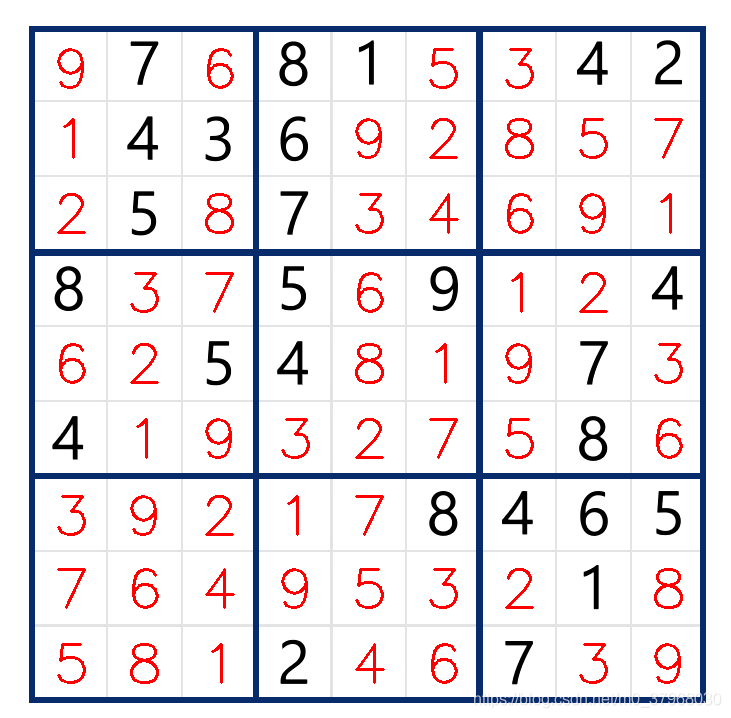这篇文章将为大家详细讲解有关利用Python如何实现识别照片中的条形码,文章内容质量较高,因此小编分享给大家做个参考,希望大家阅读完这篇文章后对相关知识有一定的了解。
最近一直在玩数独,突发奇想实现图像识别求解数独,输入到输出平均需要0.5s。
整体思路大概就是识别出图中数字生成list,然后求解。
输入输出demo
数独采用的是微软自带的Microsoft sudoku软件随便截取的图像,如下图所示:

经过程序求解后,得到的结果如下图所示:

def getFollow(varset, terminalset, first_dic, production_list):
follow_dic = {}
done = {}
for var in varset:
follow_dic[var] = set()
done[var] = 0
follow_dic["A1"].add("#")
# for var in terminalset:
# follow_dic[var]=set()
# done[var] = 0
for var in follow_dic:
getFollowForVar(var, varset, terminalset, first_dic, production_list, follow_dic, done)
return follow_dic
def getFollowForVar(var, varset, terminalset, first_dic, production_list, follow_dic, done):
if done[var] == 1:
return
for production in production_list:
if var in production.right:
##index这里在某些极端情况下有bug,比如多次出现var,index只会返回最左侧的
if production.right.index(var) != len(production.right) - 1:
follow_dic[var] = first_dic[production.right[production.right.index(var) + 1]] | follow_dic[var]
# 没有考虑右边有非终结符但是为null的情况
if production.right[len(production.right) - 1] == var:
if var != production.left[0]:
# print(var, "吸纳", production.left[0])
getFollowForVar(production.left[0], varset, terminalset, first_dic, production_list, follow_dic,
done)
follow_dic[var] = follow_dic[var] | follow_dic[production.left[0]]
done[var] = 1程序具体流程
程序整体流程如下图所示:

读入图像后,根据求解轮廓信息找到数字所在位置,以及不包含数字的空白位置,提取数字信息通过KNN识别,识别出数字;无数字信息的在list中置0;生成未求解数独list,之后求解数独,将信息在原图中显示出来。
def initProduction():
production_list = []
production = Production(["A1"], ["A"], 0)
production_list.append(production)
production = Production(["A"], ["E", "I", "(", ")", "{", "D", "}"], 1)
production_list.append(production)
production = Production(["E"], ["int"], 2)
production_list.append(production)
production = Production(["E"], ["float"], 3)
production_list.append(production)
production = Production(["D"], ["D", ";", "B"], 4)
production_list.append(production)
production = Production(["B"], ["F"], 5)
production_list.append(production)
production = Production(["B"], ["G"], 6)
production_list.append(production)
production = Production(["B"], ["M"], 7)
production_list.append(production)
production = Production(["F"], ["E", "I"], 8)
production_list.append(production)
production = Production(["G"], ["I", "=", "P"], 9)
production_list.append(production)
production = Production(["P"], ["K"], 10)
production_list.append(production)
production = Production(["P"], ["K", "+", "P"], 11)
production_list.append(production)
production = Production(["P"], ["K", "-", "P"], 12)
production_list.append(production)
production = Production(["I"], ["id"], 13)
production_list.append(production)
production = Production(["K"], ["I"], 14)
production_list.append(production)
production = Production(["K"], ["number"], 15)
production_list.append(production)
production = Production(["K"], ["floating"], 16)
production_list.append(production)
production = Production(["M"], ["while", "(", "T", ")", "{", "D", ";", "}"], 18)
production_list.append(production)
production = Production(["N"], ["if", "(", "T", ")", "{", "D",";", "}", "else", "{", "D", ";","}"], 19)
production_list.append(production)
production = Production(["T"], ["K", "L", "K"], 20)
production_list.append(production)
production = Production(["L"], [">"], 21)
production_list.append(production)
production = Production(["L"], ["<"], 22)
production_list.append(production)
production = Production(["L"], [">="], 23)
production_list.append(production)
production = Production(["L"], ["<="], 24)
production_list.append(production)
production = Production(["L"], ["=="], 25)
production_list.append(production)
production = Production(["D"], ["B"], 26)
production_list.append(production)
production = Production(["B"], ["N"], 27)
production_list.append(production)
return production_list
source = [[5, "int", " 关键字"], [1, "lexicalanalysis", " 标识符"], [13, "(", " 左括号"], [14, ")", " 右括号"], [20, "{", " 左大括号"],
[4, "float", " 关键字"], [1, "a", " 标识符"], [15, ";", " 分号"], [5, "int", " 关键字"], [1, "b", " 标识符"],
[15, ";", " 分号"], [1, "a", " 标识符"], [12, "=", " 赋值号"], [3, "1.1", " 浮点数"], [15, ";", " 分号"], [1, "b", " 标识符"],
[12, "=", " 赋值号"], [2, "2", " 整数"], [15, ";", " 分号"], [8, "while", " 关键字"], [13, "(", " 左括号"],
[1, "b", " 标识符"], [17, "<", " 小于号"], [2, "100", " 整数"], [14, ")", " 右括号"], [20, "{", " 左大括号"],
[1, "b", " 标识符"], [12, "=", " 赋值号"], [1, "b", " 标识符"], [9, "+", " 加 号"], [2, "1", " 整数"], [15, ";", " 分号"],
[1, "a", " 标识符"], [12, "=", " 赋值号"], [1, "a", " 标识符"], [9, "+", " 加号"], [2, "3", " 整数"], [15, ";", " 分号"],
[21, "}", " 右大括号"], [15, ";", " 分号"], [6, "if", " 关键字"], [13, "(", " 左括号"], [1, "a", " 标识符"],
[16, ">", " 大于号"], [2, "5", " 整数"], [14, ")", " 右括号"], [20, "{", " 左大括号"], [1, "b", " 标识符"],
[12, "=", " 赋值号"], [1, "b", " 标识符"], [10, "-", " 减号"], [2, "1", " 整数"], [15, ";", " 分号"], [21, "}", " 右大括号"],
[7, "else", " 关键字"], [20, "{", " 左大括号"], [1, "b", " 标识符"], [12, "=", " 赋值号"], [1, "b", " 标识符"],
[9, "+", " 加号"], [2, "1", " 整数"], [15, ";", " 分号"], [21, "}", " 右大括号"], [21, "}", " 右大括号"]]关于利用Python如何实现识别照片中的条形码就分享到这里了,希望以上内容可以对大家有一定的帮助,可以学到更多知识。如果觉得文章不错,可以把它分享出去让更多的人看到。
亿速云「云服务器」,即开即用、新一代英特尔至强铂金CPU、三副本存储NVMe SSD云盘,价格低至29元/月。点击查看>>
免责声明:本站发布的内容(图片、视频和文字)以原创、转载和分享为主,文章观点不代表本网站立场,如果涉及侵权请联系站长邮箱:is@yisu.com进行举报,并提供相关证据,一经查实,将立刻删除涉嫌侵权内容。